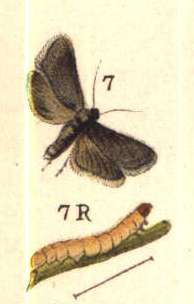
Carposinidae, the "fruitworm moths", is a family of insects in the order Lepidoptera. These moths are narrower winged than Copromorphidae, with less rounded forewing tips. Males often have conspicuous patches of scales on either surface. The mouthparts are quite diagnostic, usually with prominent, upcurved "labial palps", the third segment long, and the second segment covered in large scales. Unlike Copromorphidae, the "M2" and sometimes "M1" vein on the hindwings is absent. The relationship of Carposinidae relative to Copromorphidae needs further investigation. It is considered possible that the family is artificial, being nested within Copromorphidae. The Palearctic species have been revised by Alexey Diakonoff (1989).

Imma is a large genus of moths in the obtectomeran "micromoth" family Immidae. This is the type genus of its family. They are widespread in the tropics, with most species occurring between the Himalayas and the Oceanian region; the genus is furthermore plentiful in the Neotropics, but not very diverse in the Afrotropics.

Lecithocera is a genus of moths in the lecithocerid subfamily Lecithocerinae. The genus was erected by Gottlieb August Wilhelm Herrich-Schäffer in 1853.
Torodora is a genus of moths in the family Lecithoceridae. The genus was erected by Edward Meyrick in 1894.

Pandemis is a genus of moths of the family Tortricidae and the tribe Archipini.

Hilarographa is a genus of moths belonging to the family Tortricidae.

Cryptophlebia is a genus of moths belonging to the subfamily Olethreutinae of the family Tortricidae. It occurs in all biogeographical regions except for the Nearctic.

Grapholita is a large genus of tortrix moths. It belongs to subfamily Olethreutinae, and therein to the tribe Grapholitini, of which it is the type genus.

Acleris is a genus of moths belonging to the subfamily Tortricinae of the family Tortricidae. As of 2007, about 241 species were known.

Capua is a genus of moths belonging to the subfamily Tortricinae of the family Tortricidae.

Choreutis is a genus of moths in the family of metalmark moths (Choreutidae), and therein to subfamily Choreutinae. Of these, it is the type genus. The genus was described by Jacob Hübner in 1825.
Alexey Nikolaievich Diakonoff, also transliterated as Alexej Nikolajewitsch Diakonoff, was a Russian–Dutch entomologist who specialised in Microlepidoptera.

Gracillariinae are a subfamily of moths which was described by Henry Tibbats Stainton in 1854.
Imma niphopelta is a moth of the family Immidae. It is found in New Guinea.
Imma aritogiton is a moth in the family Immidae. It was described by Alexey Diakonoff in 1955. It is found in New Guinea.
Imma monocosma is a moth in the family Immidae. It was described by Alexey Diakonoff and Yutaka Arita in 1979. It is found on the Japanese islands of Kyusyu and Honshu.
Imma tetrope is a moth in the family Immidae. It was described by Alexey Diakonoff in 1978. It is found in Nepal.









